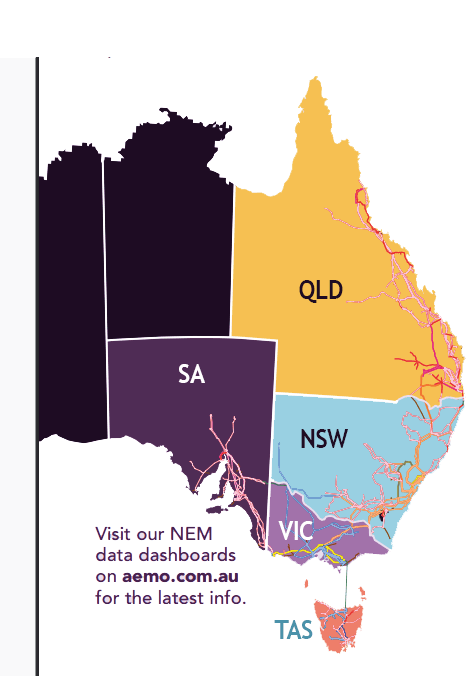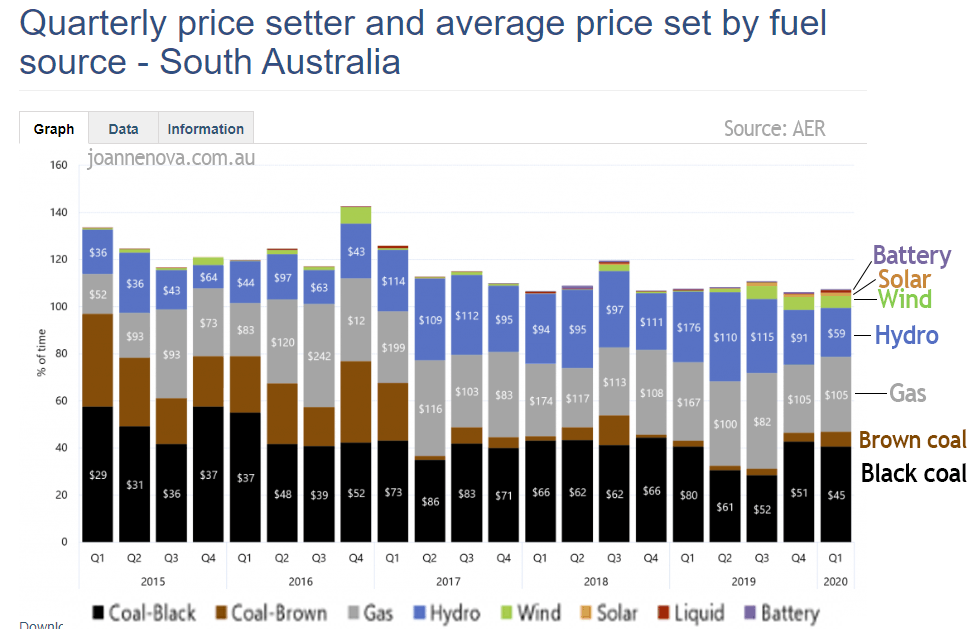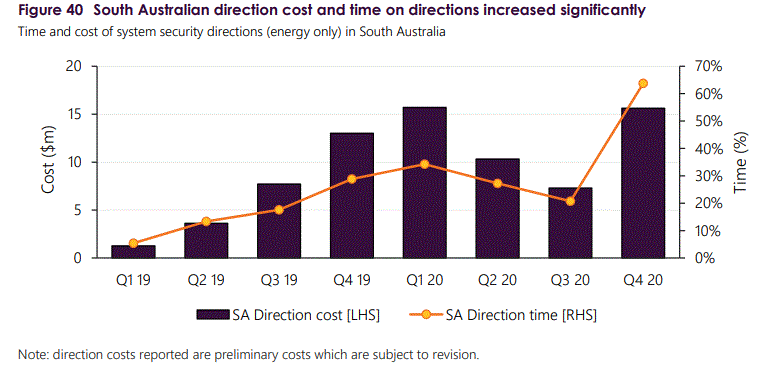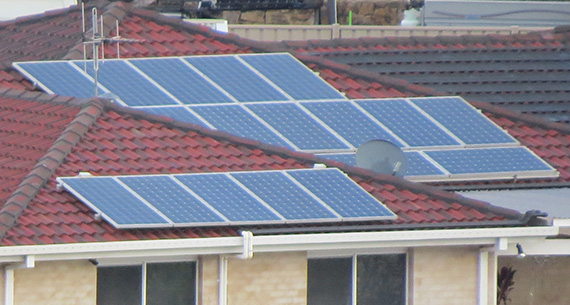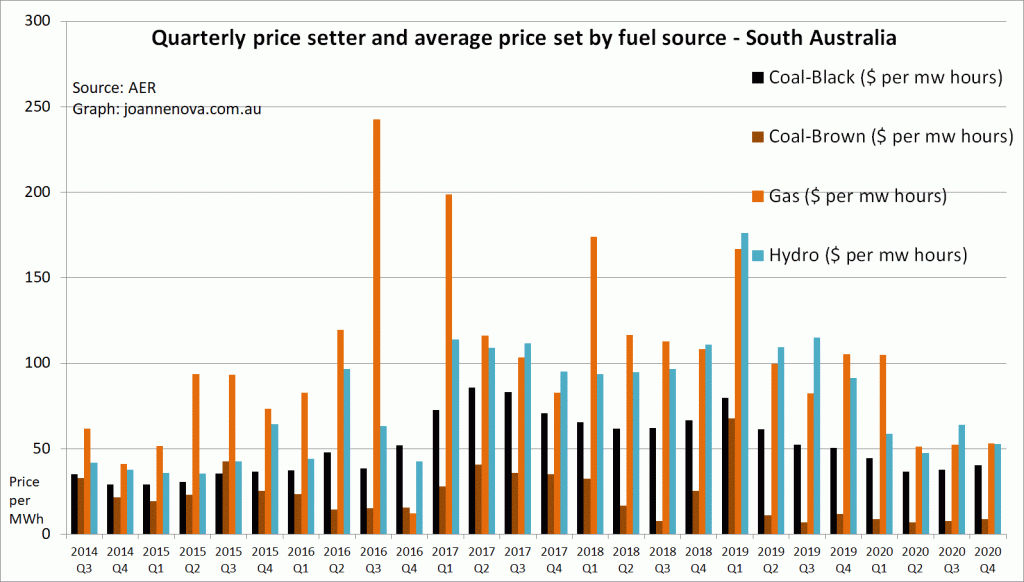Yallourn, in the Latrobe Valley, provides up to 20 per cent of Victoria’s power. It has been operating for 47 years. Since late 2017 at least one of its four units has broken down 50 times. Its workforce doubles for three to four months most years to deal with the breakdowns. It pumps out 3 per cent of Australia’s carbon emissions.
Martin goes on in a non-stop infomercial for wind and solar
And the closure of coal plants doesn’t cause prices to fall either. More coal means cheaper electricity.
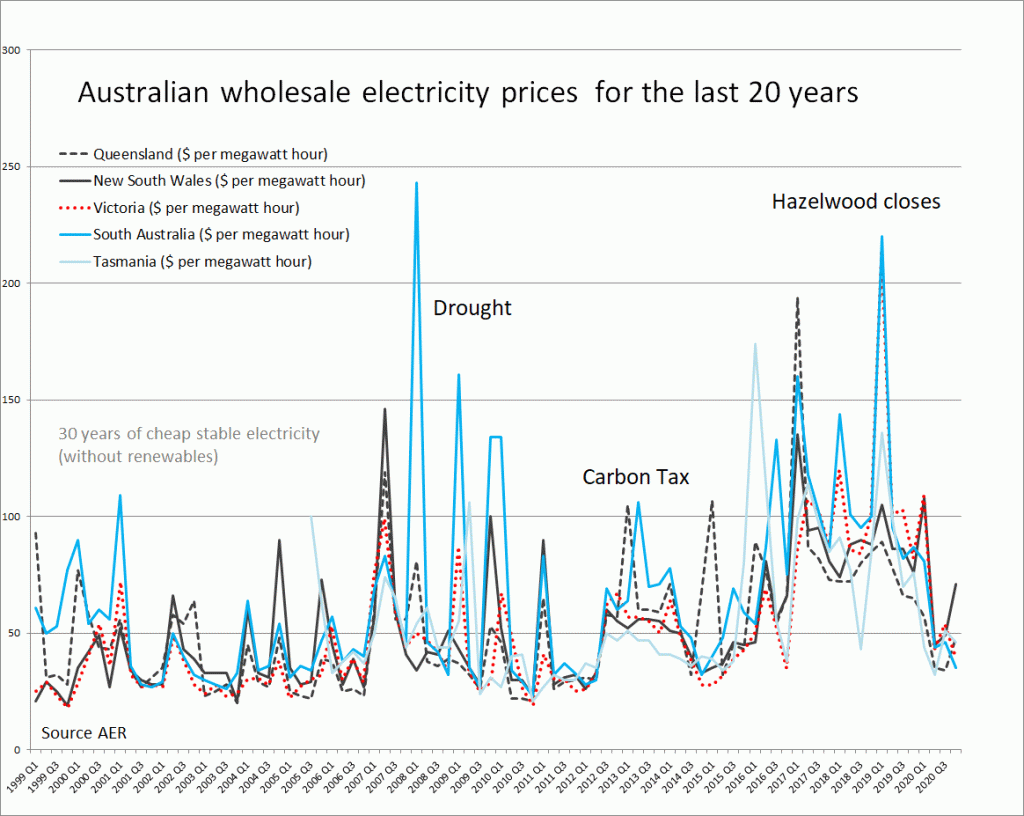
Fig 3: All those renewables, and yet prices are still not as low as what they were when we didn’t have them.
South Australia might be a renewables superstar but guess where their cheapest reliable power comes from … black coal
The only thing cheaper than black coal is brown coal. Most of the hours of the day the price in South Australia is not being set by solar or wind power.
SA system costs keep rising
Another record! South Australia had to spend $15 million last quarter on “system security directions”. The AEMO were very busy ordering the Gas Powered generators (GPG) to stay on.
In 2020, total costs for directing South Australian generators for system strength was $49 million (or
$4/MWh), $23 million higher than 2019. During the quarter, AEMO continued to issue directions to GPGs in
South Australia and initiated directing hydro generators in Tasmania to maintain system security.
In contrast to falling wholesale electricity prices in South Australia, out-of-market costs in the region have been rising. This quarter, South Australian generators’ time on directions reached a record quarterly high of
64%, surpassing the previous record set in Q2 2018 (45%). This resulted in South Australian system strength
direction costs reaching near record quarterly levels of $15.6 million (Figure 40).
NSW prices spiked because 3,000 MW of coal power was out of action (mostly planned maintenance)

Figure 6. Look which state turned of it’s cheap black coal supplies last quarter for planned maintenance.
More solar PV is the system vandal that makes coal power more expensive
Critics may argue that Solar PV on rooftops doesn’t bid, but “sets” the price by reducing demand. But renewables and coal are not swappable services. Being cheaper at noon can mean being more expensive at most other hours of the day. Random “free energy”, just steals profits from coal, makes a whole lot of infrastructure and staff sit around doing nothing on a long lunch, and run less efficiently when it tries to fill in for the energy vandal forced on the system. When the sun goes down the whole solar team and capital sit around powering nothing too.
Coal plus solar can not possibly be cheaper than coal alone. It takes more people, more capital, more land, more maintenance. In the hours solar runs, all the useful coal infrastructure has to still be there, waiting to step in. The only cost “savings” to the large coal plants is a few truckloads of coal. All the other costs are the same or higher. The solar electrons are simply surplus random supply that “is the part of the jigsaw that doesn’t fit in” (to use Peter Martin’s words).
Coal also used to provide all that frequency stability we need for free and on call 24/7 and then feed our crops free fertilizer as an unlisted bonus.
How to create market chaos and a price spike
After Hazelwood shut in 2017, the cheapest form of electricity (brown coal) suddenly couldn’t supply enough electricity to set the final price of supply very often. That’s why the system price leapt. Hazelwood was in Victoria but the effect can even be seen in South Australia in Figure 3 above, where brown coal stops setting the price as often from Q2 onwards in 2017. That was “the Hazelwood effect”.
Brown coal fired generators are still sometimes setting the final winning bids at under $10/MWh. Its unbelievably, unbeatably cheap. No wonder all the junk expensive system vandals want to close brown coal stations.
The screwed market — a world of negative prices
The low quarterly prices in South Australia were partly due to negative prices, which “cut South Australia’s average by $8.7/MWh.”
This is a graph below of the main fuels setting wholesale prices in South Australia. The brown coal average winning bids are so low they are hard to see. Gas power and hydropower are obviously setting higher prices. The black coal winning bids have settled now in the new post Hazelwood bountiful world of renewables, at a higher price than they were. Genius.
But sometimes solar and wind power win bids too. Have a look at what happens to this same graph when their winning bids are added in (below). The effect of the large deeply negative bids changes the scale of the graph and pretty much defies any sense at all. Why would anyone pay money to provide electricity? In a normal market we only pay people to take away rubbish.
Is this craziness entirely a product of the subsidies? Is that what makes it possible to bid so deeply negative and “still make a profit” or are some of the players trying to game the system but losing?
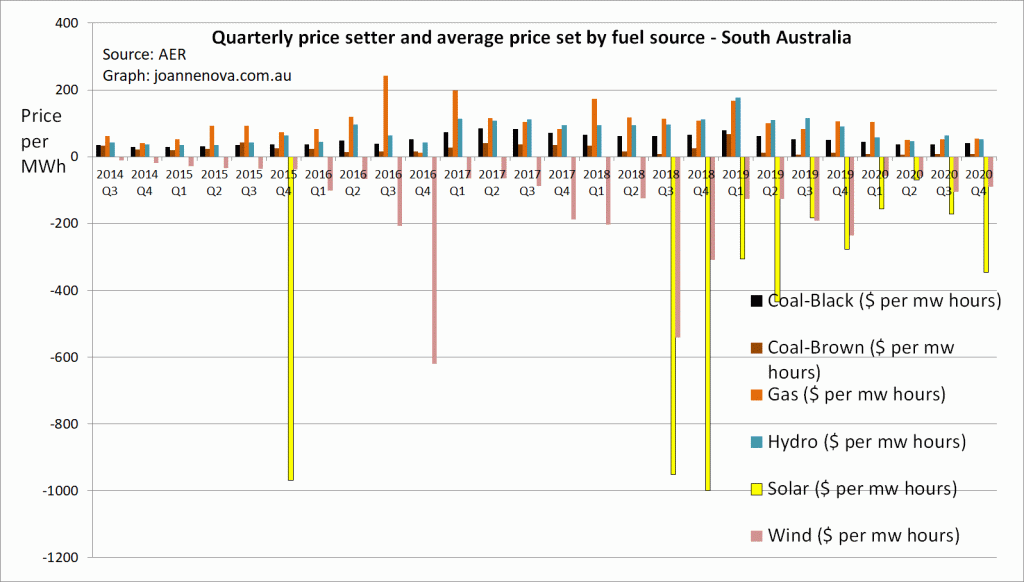
Fig 8: The Negative price bids are all thanks to solar and wind power and are “off the chart”. | Click to wallow in a fake market.
On the NEM, suppliers bid in the hope that someone bidding a lot higher than them wins the last successful ticket in the stack. Then all successful bidders all get paid at that same top winning rate. Obviously, generators don’t want to bid too high, or they earn nothing at all. But the race to the bottom seems kinda odd (to say the least). If they win at minus $1,000/MWhr, then they have to supply the electricity AND pay til it burns for it too.
In the end, if the negative bids reduced the wholesale price of electricity by $8/MWh but that’s only due to subsidies, it’s not a savings at all, it’s just a redistribution. Someone else had to pay. It’s false advertising yet again.
The AEMO report remarks on the record amount of negative prices in Q4 last year.
1.3.3 Negative wholesale electricity prices
During Q4 2020, negative and zero spot prices occurred in 7% of all trading intervals, surpassing the
previous record set in Q3 2020 (4.6%), with calendar year 2020 averaging 4.4% compared to 1.7% in 2019.
Negative spot prices were most prevalent in South Australia and Victoria, with both states reaching record
quarterly levels. South Australia’s spot prices were negative 17% of the time during Q4 2020, exceeding the
previous quarterly of 10%, while Victoria reached a new record of 10%.
Despite the record occurrence of negative spot prices, the impact on the quarterly average prices was limited.
Negative prices cut South Australia’s average by $8.7/MWh, while the impact was less in Victoria ($2.4/MWh)
and Queensland ($0.9/MWh) due to fewer very low prices below minus $100/MWh
Peter Martin — economist of some sort, thinks negative pricing means being paid to “turn off”. His junk commentary is “not even wrong” but for 17 years he was the ABC’s economics correspondent. He is so wrong he was awarded an Member of the Order of Australia (AM). Flinders uni taught him economics. They have a lot to answer for.
Peter Martin says:
Being even cheaper than the power produced by the old brown-coal-fired power stations, there is at times so much it that it sends prices negative, meaning generators get paid to turn off in order to avoid putting more power into the system than users can take out.
It’s one of the reasons coal-fired plants are closing: they are hard to turn off. They are just as hard to turn on, and pretty hard to turn up.
He is making mistakes piled on mistakes. Firstly he’s confusing negative prices with something called “Demand management”. Secondly he thinks the new random and volatile grid is progress instead of being an unnatural artificial forced transition that no one needed to have but we were all coerced into paying for.
In the new vandalized grid, no one wants to put money into coal maintenance. Plus the companies that own coal own the unreliables. What could possibly go wrong?
REFERENCES:
Australian Energy Regulator (AER) https://www.aer.gov.au/wholesale-markets/wholesale-statistics/annual-volume-weighted-average-spot-prices-regions
Australian Energy Regulator (AER): aer.gov.au/wholesale-markets/wholesale-statistics/quarterly-price-setter-and-average-price-set-by-fuel-source-south-australia
